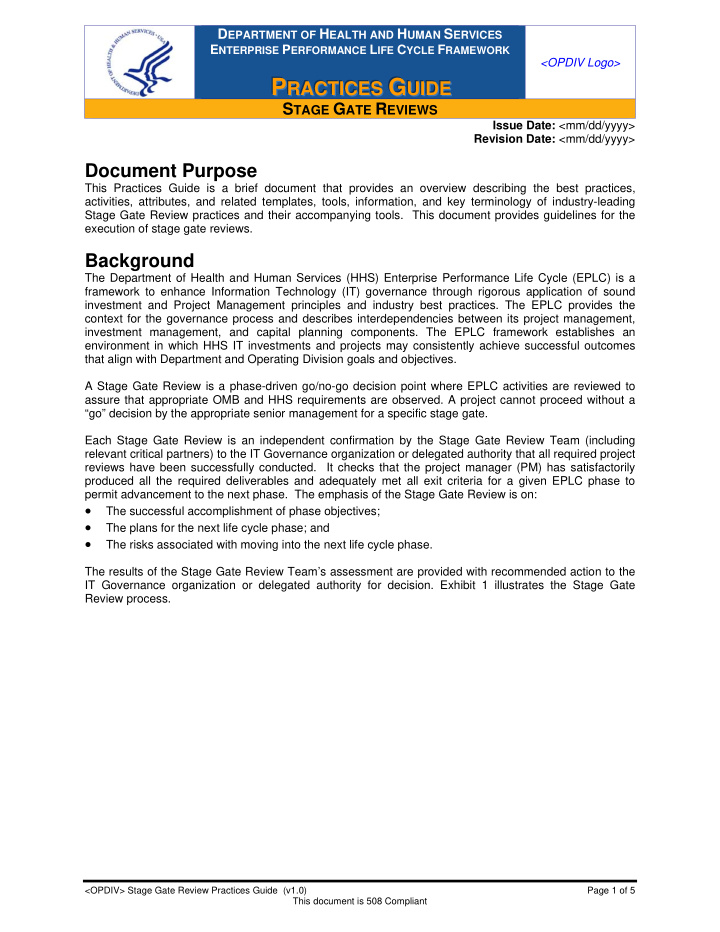



D EPARTMENT OF H EALTH AND H UMAN S ERVICES E NTERPRISE P ERFORMANCE L IFE C YCLE F RAMEWORK <OPDIV Logo> P G E P R G U P S G R A C T I C E S U I D E RA AC CT TI IC CE ES UI ID DE S TAGE G ATE R EVIEWS Issue Date: <mm/dd/yyyy> Revision Date: <mm/dd/yyyy> Document Purpose This Practices Guide is a brief document that provides an overview describing the best practices, activities, attributes, and related templates, tools, information, and key terminology of industry-leading Stage Gate Review practices and their accompanying tools. This document provides guidelines for the execution of stage gate reviews. Background The Department of Health and Human Services (HHS) Enterprise Performance Life Cycle (EPLC) is a framework to enhance Information Technology (IT) governance through rigorous application of sound investment and Project Management principles and industry best practices. The EPLC provides the context for the governance process and describes interdependencies between its project management, investment management, and capital planning components. The EPLC framework establishes an environment in which HHS IT investments and projects may consistently achieve successful outcomes that align with Department and Operating Division goals and objectives. A Stage Gate Review is a phase-driven go/no-go decision point where EPLC activities are reviewed to assure that appropriate OMB and HHS requirements are observed. A project cannot proceed without a “go” decision by the appropriate senior management for a specific stage gate. Each Stage Gate Review is an independent confirmation by the Stage Gate Review Team (including relevant critical partners) to the IT Governance organization or delegated authority that all required project reviews have been successfully conducted. It checks that the project manager (PM) has satisfactorily produced all the required deliverables and adequately met all exit criteria for a given EPLC phase to permit advancement to the next phase. The emphasis of the Stage Gate Review is on: • The successful accomplishment of phase objectives; • The plans for the next life cycle phase; and • The risks associated with moving into the next life cycle phase. The results of the Stage Gate Review Team’s assessment are provided with recommended action to the IT Governance organization or delegated authority for decision. Exhibit 1 illustrates the Stage Gate Review process. <OPDIV> Stage Gate Review Practices Guide (v1.0) Page 1 of 5 This document is 508 Compliant
HHS EPLC Practices Guide - <OPDIV> Stage Gate Review Practices Guide (v1.0) < MM / DD / YYYY > Exhibit 1 – Stage Gate Review Process Practice Overview The Stage Gate Review is the evaluation process by which a project is authorized to progress from one life cycle phase to the next. It is a collaborative practice in which all participants play an important role in assessing the project’s overall health and quality of execution to empower the IT Governance organization or delegated authority to make an informed decision as to whether the project is ready to enter the next phase of its lifecycle and receive further resource commitments. It provides the PM and the Business Owner the benefit of having an independent body review the project. This section summarizes a standardized approach to conducting a Stage Gate Review. Given that each project, product, and investment is different, the intent of each Stage Gate Review will slightly vary. Regardless of what form the review takes, it must adhere to the approved level of project tailoring as defined in the Project Process Agreement deliverable. Stage Gate Reviews have a common set of components which include: • Inputs: These are the deliverables associated with the phase under review; the results/findings of any related programmatic and project reviews (e.g., Architecture Review, Independent Baseline Reviews, Audits, Cost and Schedule Reporting; Re-baseline Request); the results of corrective actions associated with any previous stages; and updates to any previously reviewed deliverables. [Note that prior deliverables (e.g., Project Process Agreement, Project Management Plan, and Business Case) should be available for reference upon request to provide further context to the Stage Gate Review Team.] • Exit Criteria: The HHS EPLC Framework defines exit criteria for each stage gate and provides guidance on the critical factors associated with the subject Stage Gate Review. These criteria are the questions or guidelines against which the project will be evaluated in order to make a recommendation (i.e., Approve, Conditionally Approve, or Not Approved). • Review Process: The Stage Gate Review Team reviews the deliverables and selected documentation based on the criteria above. The review may include a panel discussion between the Stage Gate Review Team and project teams which offer the project team an opportunity for dialogue and to respond to additional questions from the review team. • Outputs: These are the results of the Stage Gate Review. This should include a recommendation to the IT Governance organization or delegated authority with supporting documentation/justification. Other outputs may include requirements for the submission of a corrective plan of action and milestones to address issues in the event of a conditional approval to proceed to the next phase. <OPDIV> Stage Gate Review Practices Guide (v1.0) Page 2 of 5 This document is 508 Compliant
Recommend
More recommend